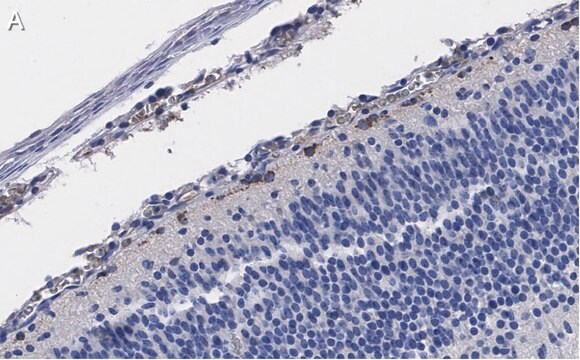추천 제품
생물학적 소스
mouse
Quality Level
결합
unconjugated
항체 형태
ascites fluid
항체 생산 유형
primary antibodies
클론
1H4, monoclonal
분자량
36 kDa
종 반응성
human
기술
direct ELISA: 1:10,000
flow cytometry: 1:200-1:400
immunohistochemistry: 1:200-1:1,000
western blot: 1:500-1:2,000
동형
IgG1
NCBI 수납 번호
UniProt 수납 번호
배송 상태
wet ice
저장 온도
−20°C
타겟 번역 후 변형
unmodified
유전자 정보
human ... ApoE(348)
일반 설명
Apolipoprotein E (ApoE) belongs to a group of proteins that bind reversibly with lipoproteins. Significant quantities of ApoE are produced in liver and brain and to some extent in almost every organ. ApoE is an important constituent of all plasma lipoproteins. ApoE exists in three major isoforms; E2, E3, and E4, which differ from one another by a single amino-acid substitution. Compared with E3 and E4, E2 exhibits the lowest receptor binding affinity. E2 allele carriers have significantly lower levels of total cholesterol, low-density lipoprotein cholesterol, and non-high-density lipoprotein cholesterol, as well as increased ApoE levels. The gene encoding this protein is localized on human chromosome 19q13.32.
면역원
Purified recombinant fragment of human ApoE expressed in E.coli.
Mouse monoclonal antibody raised against ApoE
Mouse monoclonal antibody raised against ApoE
생화학적/생리학적 작용
In addition to facilitating solubilization of lipids, apolipoproteins help to maintain the structural integrity of lipoproteins, serve as ligands for lipoprotein receptors, and regulate the activity of enzymes involved in lipid metabolism. Apolipoprotein E (ApoE) plays an important role in lipid metabolism. It′s interaction with specific ApoE receptor enables uptake of chylomicron remnants by liver cells, which is an essential step during normal lipid metabolism. It also binds with the LDL receptor (Apo B/E). Defects in ApoE are a cause of hyperlipoproteinemia type III.
물리적 형태
Ascitic fluid containing 0.03% sodium azide.
면책조항
Unless otherwise stated in our catalog or other company documentation accompanying the product(s), our products are intended for research use only and are not to be used for any other purpose, which includes but is not limited to, unauthorized commercial uses, in vitro diagnostic uses, ex vivo or in vivo therapeutic uses or any type of consumption or application to humans or animals.
적합한 제품을 찾을 수 없으신가요?
당사의 제품 선택기 도구.을(를) 시도해 보세요.
Storage Class Code
10 - Combustible liquids
WGK
WGK 3
Flash Point (°F)
Not applicable
Flash Point (°C)
Not applicable
가장 최신 버전 중 하나를 선택하세요:
Anja Beierfuß et al.
PloS one, 12(11), e0187564-e0187564 (2017-11-04)
Intervertebral disc (IVD) degeneration that accelerates the loss of disc structural and functional integrities is recognized as one of the major factors of chronic back pain. Cardiovascular risk factors, such as deficits of apolipoproteins that elevate the levels of cholesterol
Michael C Phillips
IUBMB life, 66(9), 616-623 (2014-10-21)
Apolipoprotein (apo) E is a 299-residue protein which functions as a key regulator of plasma lipid levels. Human apoE exists as three common isoforms and the parent form, apoE3, operates optimally in promoting clearance of triglyceride (TG)-rich lipoproteins and is
R W Mahley et al.
Journal of lipid research, 40(11), 1933-1949 (1999-12-20)
Type III hyperlipoproteinemia (HLP) is a genetic disorder characterized by accumulation of remnant lipoproteins in the plasma and development of premature atherosclerosis. Although receptor binding-defective forms of apolipoprotein (apo) E are the common denominator in this disorder, a number of
Martine Prévost et al.
Proteins, 55(4), 874-884 (2004-05-18)
Apolipoprotein E (apoE) is an important protein involved in lipid metabolism due to its interaction with members of the low-density lipoprotein receptor (LDLR) family. To further understand the molecular basis for this receptor-binding activity, an apoE fragment containing the receptor
Joris Deelen et al.
Aging cell, 10(4), 686-698 (2011-03-23)
By studying the loci that contribute to human longevity, we aim to identify mechanisms that contribute to healthy aging. To identify such loci, we performed a genome-wide association study (GWAS) comparing 403 unrelated nonagenarians from long-living families included in the
자사의 과학자팀은 생명 과학, 재료 과학, 화학 합성, 크로마토그래피, 분석 및 기타 많은 영역을 포함한 모든 과학 분야에 경험이 있습니다..
고객지원팀으로 연락바랍니다.








